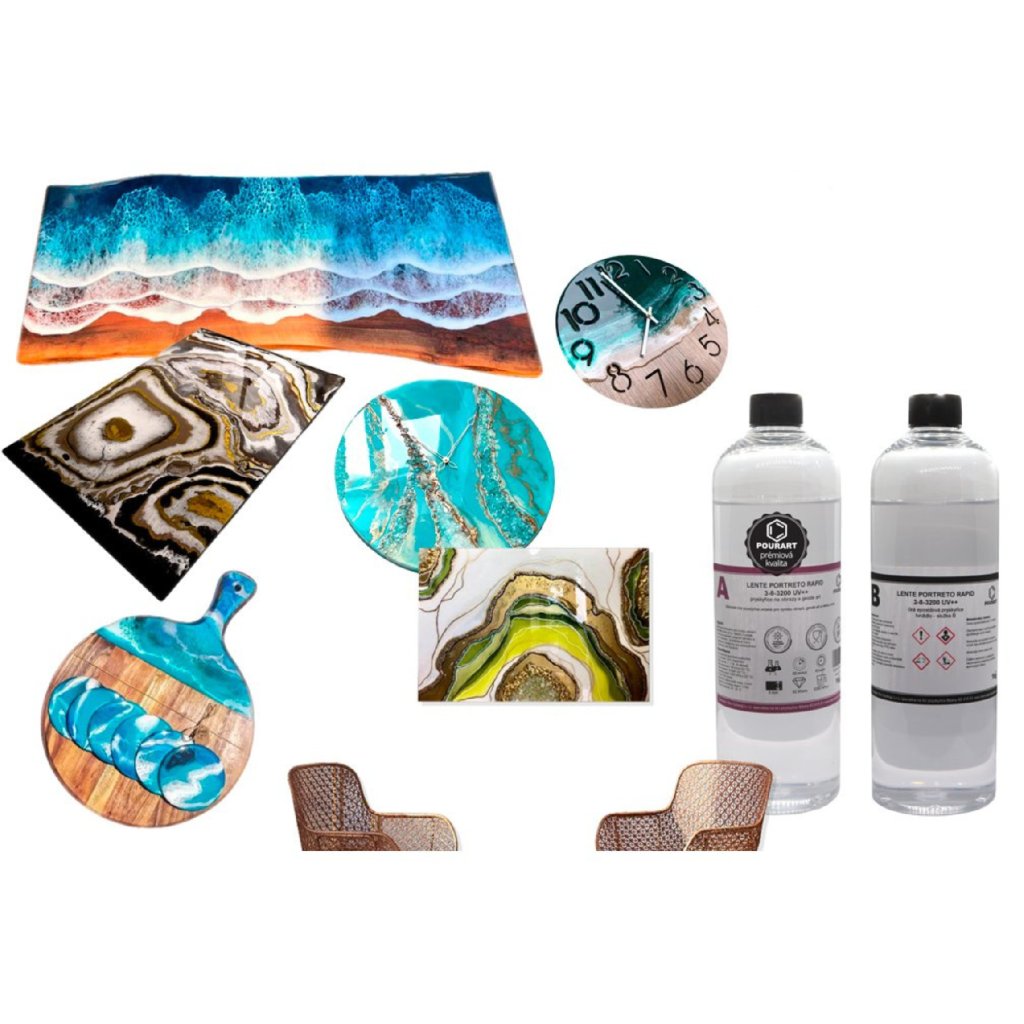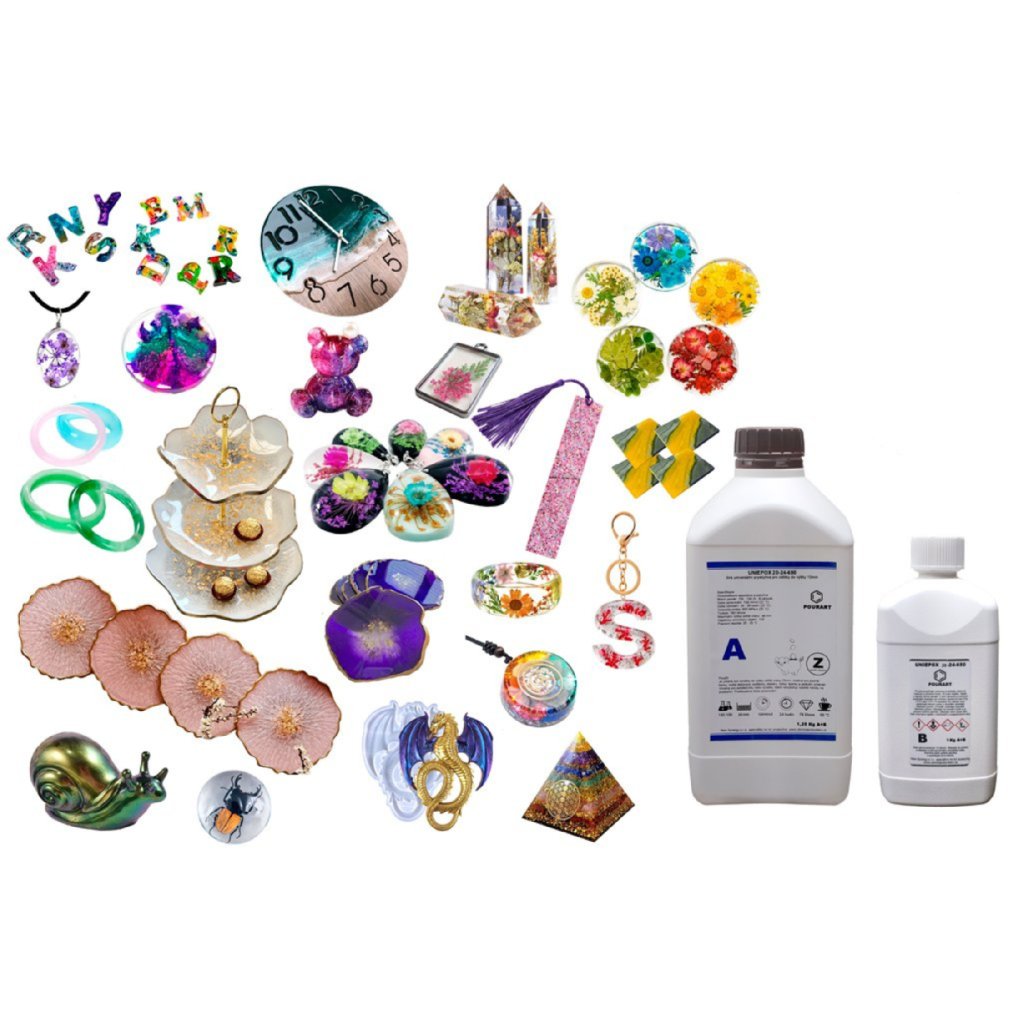Epoxy Resin – overview, selection & guides
A comprehensive guide to epoxy casting resins: how to choose the right system for jewelry, decor, artwork and larger castings. Practical tables, consumption calculations, error prevention, product recommendations and related tutorials.
New formulas – recommended
Recently introduced blends focused on clarity, comfortable open time and stable curing. Recommended for decor, dried flowers and flat projects:
What epoxy casting resin is
Epoxy is a two-component system (A – resin, B – hardener). When mixed at the prescribed ratio, a reaction produces a rigid, transparent material. For casting resins, the key choices are viscosity, recommended layer height and open time; these parameters affect bubble formation, overheating (exotherm) and final clarity.
How to choose the right system
1) By project and casting size
Jewelry, coasters and small molds tolerate faster blends. Massive blocks (lamps, large decor) require “slower” systems with longer cure to minimize overheating and shrinkage.
2) By recommended layer height
Each product specifies a safe single-pour height and volume per batch. Following it is crucial for clarity and stability without haze or internal cracking.
3) By viscosity and open time
Thinner blends de-air better and capture fine detail; thicker ones keep color bands separated (artwork, geodes). Longer open time helps with 10+ mm layers and multi-layer projects.
4) By UV stability and certifications
Higher UV stability helps maintain long-term clarity. For food-contact surfaces (boards, trays, countertops) a food-contact certification of the cured surface is a plus.
Recommendations by project (table)
| Project | Recommended type | Single-layer height | Work tip | Category |
|---|---|---|---|---|
| Jewelry, pendants | Thin, crystal-clear | 3–10 mm | Clean molds, weigh by scale | Resins for jewelry |
| Coasters, tiered trays | Thin to medium | 3–8 mm | Use restrained colors for clear edges | Resins for coasters |
| Art panels, geodes | Thicker, self-levelling | 1–3 mm | Flat substrate and ventilation | Resins for artwork |
| Dried flowers & decor | Thin, clear | 5–15 mm | Material perfectly dry; pour in layers | Resins for decor |
| Large decor, lamps | Deep pour (longer cure) | 10–30 mm | Stable setup, no vibrations, patient curing | Large decor |
| Cutting boards, serving | Hard, durable topcoat | 1–2 mm | Even flow, let fully cure | Board resins |
| Furniture surfaces | UV-resistant systems | 1–2 mm | Dust control, self-levelling | Furniture surfaces |
| Wood & resin decor | Thin, clear | 5–20 mm | Dry wood; seal pores first | Wood & resin decor |
Recommended epoxy resins (selection)
Choose by layer height
| Layer range | Suitable products (selection) | Work note |
|---|---|---|
| Up to ~5 mm | Subglaso Rapid · Lente Portreto 3-8-3200 | Coasters, art panels, surface coats. |
| ~5–15 mm | Uniepox · FLOWERA · DEKORA 20-24-950 | Decor, dried flowers, smaller castings. |
| 15 mm and more (in stages) | DEKORA 50-48-660 · TABULA 50-48-660 · Tabula BASIC | Layered pours; keep time intervals and temperature. |
Choose by viscosity
| Group | Best for | Products (selection) |
|---|---|---|
| Thin | Mold details, fewer bubbles, clear edges | Subglaso Rapid · DEKORA 20-24-950 · Tabula BASIC |
| Medium | General decor, flowers, smaller volumes | Uniepox · FLOWERA · DEKORA 50-48-660 · TABULA 50-48-660 |
| Thicker | Art techniques, separated color bands, artwork | Lente Portreto 3-8-3200 · Lente Portreto 10-16-6000 |
Clear vs. crystal-clear resin
In thin layers, the difference is usually minimal. Crystal-clear systems are further refined and optimized for higher optical quality in larger volumes: less micro-haze, a more pronounced “glassy” look. If your casting must be fully transparent and relatively thick, the crystal-clear variant delivers the best visual result. With fully pigmented castings (metal powders, mica) the difference is typically negligible.
Mixing & work environment
Weighing and the “double-cup” method
Mix by weight per instructions (accuracy at least 0.1 g) for 2–3 minutes, scraping walls and bottom. Then decant into a clean cup and mix briefly again (the “double-cup”). This reduces the risk of unmixed residues.
Temperature, humidity and cleanliness
- Working temperature ~22–23 °C without swings.
- Bring materials and molds to room temperature; cold materials raise viscosity and bubbles.
- Cover after pouring to protect from dust (box, simple “tent”).
Tip: Tacky surfaces or softness are most often caused by an incorrect A:B ratio, insufficient mixing, or low temperature. See fixes in the FAQ section.
Coloring & pigment compatibility
- Transparent dyes: Accentuate depth and embedded objects; dose sparingly.
- Metallic / mica powders: Shimmer and marbling; pre-mix into a small portion of resin, then add in portions.
- Alcohol inks: Cloud effect; add minimally (risk of pores at higher dosage).
- Water-based acrylics: Excess water causes haze—use pigments made for epoxy.
Molds & demolding
Keep silicone molds clean and dry. Wipe with isopropyl alcohol and dry before pouring. For complex shapes, a light release agent helps. Worn molds may leave a matte finish—polish or overcoat with a thin clear layer. See silicone molds and, for orgonite, silicone molds for orgonites.
How to read technical data sheets (quick guide)
| Parameter | Practical meaning | Watch out for |
|---|---|---|
| Mix ratio (by weight) | Accurate weighing = reliable curing | “By volume / by eye” is inaccurate |
| Viscosity (mPa·s) | Lower = thinner, better de-airing; higher = better color hold | Thin blends flow more—keep the surface level |
| Open time / pot life | Working window | Short time + large volume = overheating risk |
| Max. layer height | Safe limit per single pour | Do not exceed; for large pieces, pour in stages |
| Shore D hardness | Scratch resistance after cure | Higher value is preferable for topcoats |
How much resin to order (calculation)
Casting volume V = length × width × height (in cm). 1 cm³ = 1 ml ≈ 1 g. Add a 5–10 % reserve for losses in cups and on walls.
| Shape | Formula | Example | Mix required |
|---|---|---|---|
| Rectangle (coaster) | L × W × h | 10 × 10 × 0.6 cm = 60 cm³ | ~60–66 ml |
| Circle (tier tray) | π × r² × h | r=8 cm, h=0.5 cm → ~100 cm³ | ~100–110 ml |
| Pyramid | (base × height) / 3 | 9×9×7 cm → 189 / 3 | ~63–70 ml |
| Cylinder (lamp) | π × r² × h | r=5 cm, h=15 cm → ~1,178 cm³ | ~1.18–1.3 l |
Tip: For wood-resin combinations, subtract the wood volume (roughly by water displacement and converting to ml).
Common selection mistakes (and how to avoid them)
- Too fast a system for a large volume: High exotherm, haze, internal stress risk. Fix: deep-pour systems and layered casting.
- Exceeding layer height: Even quality resin can go cloudy. Keep to the product limit.
- “By eye” volumetric mixing: Always weigh on a digital scale (0.1 g).
- Cold materials and molds: Increase viscosity and bubbles. Bring to room temperature.
- Wrong resin for art panels: Thin blends spread colors; choose a thicker system for art techniques.
Care of finished pieces
Clean with a soft cloth; avoid abrasive pads and harsh cleaners. Do not expose to prolonged direct sun or localized high heat. For food-contact surfaces, respect full cure before first use.
Mini-glossary
- Viscosity: Measure of blend “thinness/thickness”; affects de-airing and color behaviour.
- Open time / pot life: Usable time before gelation.
- Exotherm: Heat released during reaction; too rapid heating causes haze or sink marks.
- Gelation: Moment the blend thickens and stops flowing.
Pre-purchase checklist
- Project and target layer thickness (mm/cm)
- Desired look (fully clear vs. colored/metallic)
- Recommended layer height and open time in the datasheet
- Viscosity (thin for casting, thicker for art panels)
- UV stability; food-contact certification if needed
- Enough material + 5–10 % reserve
FAQ
How do I pick a suitable resin for a specific project?
Primarily by casting size, target layer height and desired appearance. Thin, crystal-clear blends fit small molds; use longer-curing deep-pour systems for larger castings.
Can I mix different resin systems together?
Not recommended. Each system has its own hardener and A:B ratio; mixing increases the risk of incomplete cure and degraded properties.
How can I reduce bubbles?
Keep materials and molds at room temperature, pour a thin stream in layers, and briefly waft warm air from a distance. For large volumes choose longer open time systems.
How to prevent yellowing?
Select systems with higher UV stability, don’t exceed recommended cure temperatures, and avoid long-term direct sunlight on finished pieces.
Related tutorials & sections











